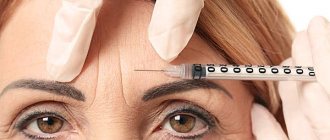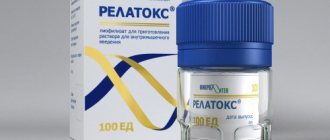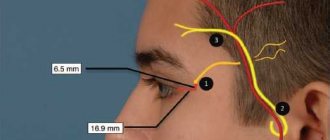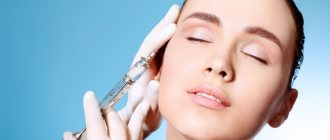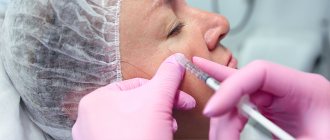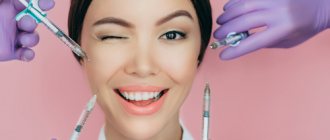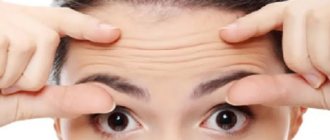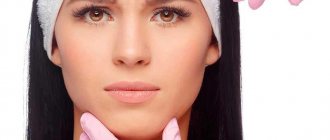- Botulinum toxin Botox (Botox)
- What happens after the procedure
- Video about how the drug works
- Botulinum toxin injections in the forehead
- Injections into the armpits
- The Myth of Botox
- The most common areas for Botox injections
- Photos before and after the procedure
- Prices
- Reviews from cosmetologists
Botulinum toxin Botox is a well-known drug based on botulinum toxin, which has been used in cosmetology for many years. The manufacturer of the drug Botox is the pharmaceutical company Allergan (USA). It is used to eliminate facial wrinkles in the area between the eyebrows, forehead, and area around the eyes (“crow’s feet”). The drug has been used in medicine since 1988, during which time the drug has conquered the world and proven its safety and effectiveness.
What happens after the procedure
After Botox injections, facial muscles relax and, as a result, wrinkles smooth out. The effect of one procedure lasts from 3 to 9 months, after which it can be repeated. The duration of the effect depends on the dose of the drug, the characteristics of the body, and lifestyle.
Botulinum toxin - its injections not only “remove” wrinkles, but also serve as a good prophylactic agent for active facial expressions. This procedure will easily wean you from frowning and, ultimately, will help keep your skin smooth for a long time.
The injections themselves are well tolerated and do not require special preparation. Immediately after the procedure, you can return to your normal activities.
Possible side effects
Complications occur when the cosmetologist’s recommendations are not followed or when the dosage of the drug is incorrectly calculated.
Side effects:
- Swelling. Most likely to occur in people with vascular diseases, hormonal imbalances and alcoholism. Often the swelling goes away on its own after a few days. If the swelling does not go away, you need to contact a cosmetologist again.
- Facial asymmetry. If the drug spreads beyond the target zone, asymmetry appears. In this case, it is often impossible to correct the shape of the face; you should wait until the botulism is eliminated by the lymphatic system. Additional injections for correction may worsen the problem.
- Articulation problems. They arise due to too much injected volume of the drug into the corners of the lips or into the muscles that control their movements. Possible drooling.
- Headache. This consequence is caused by overstraining some muscles while relaxing others or improper recovery after the procedure. In some patients, the headache persists for up to two weeks.
- Seals. If the drug is distributed unevenly, bumps appear under the skin. This occurs due to an excessive dose of the administered drug or an individual reaction. The seals can be corrected 2 weeks after the session.
Side effects that do not indicate problems are dizziness, a slight rise in temperature, nausea, and weakness. These unpleasant consequences will soon disappear.
A critical condition after botulinum toxin injections is indicated by numbness of the limbs and rapid heartbeat. If these signs are noticed, you should consult a doctor as soon as possible.
Botulinum toxin injections in the forehead
The appearance of wrinkles in the forehead area at the age of 35-45 years is a fairly typical development of the situation, due to a decrease in skin turgor and age-related changes. The most effective way to eliminate this deficiency is by local administration of drugs based on botulinum toxin. During the blocking of neuromuscular transmission, the transverse grooves formed by the contraction of the facial muscles straighten. The entire procedure takes just a few minutes, so it is usually performed without anesthesia.
Since as a result of the procedure neither the muscles nor the nerve fibers are affected, therefore after 4-6 months the condition returns to the original level, repeated administration is necessary. At the same time, the professionalism of a cosmetologist is not to immobilize the muscles, but only to relieve their increased tone. This approach further ensures natural facial expressions and eliminates the appearance of a mask-like face. The drugs used to achieve this effect are usually Botox or Dysport.
Make an appointment right now!
We have extensive experience and real results
Sign up
Contraindications
Before receiving permission to perform the procedure, the patient of the clinic is carefully questioned to ensure that he has no contraindications to the use of Botox. The following pathologies may be prohibited for manipulation:
- oncology;
- diseases of nervous and muscle tissue;
- blood clotting disorder;
- epilepsy;
- infection or injury in the area where the medication was administered;
- allergy to drug components;
- unstable psychostatus of the patient;
- taking certain medications (antibiotics, muscle relaxants, antiplatelet agents).
Absolute contraindications for injections with botulinum toxin are periods of pregnancy and breastfeeding. Temporary limitations that do not allow the procedure to be performed are acute respiratory infections and exacerbation of chronic diseases.
Botulinum toxin injections into the armpits
The ability to straighten wrinkles is not the only effect of topical use of botulinum toxin-based drugs. Botox or Dysport are also used in the treatment of hyperhidrosis, a condition marked by increased sweat production. In this case, the introduction of botulinum toxin and blocking neuromuscular transmission leads to the fact that the sweat gland significantly reduces its secretion. By injecting the drug into the armpit area, it is possible to get rid of not only the unpleasant odor, but also excess moisture for a long period of time, up to six months.
Sweating plays an important role in maintaining the body's water-salt balance and freeing it from waste products. When turning to such a procedure, specialists carefully study all the associated factors and causes of hyperhidrosis.
Attention: Botox injections can only be performed by a qualified specialist who has undergone appropriate training.
Don't put it off until tomorrow. Call us and sign up for the procedure today!
Mechanism of action
Botulinum toxin is a neurotoxin. It blocks the release of acetylcholine, which is involved in the transmission of nerve impulses at neuromuscular synapses. Thus, if the nervous system sends a signal to the muscles, it does not reach the point of application. Consequently, the muscle remains in a relaxed state. Local administration of the substance in small concentrations allows for relaxation of certain muscles. That is why botulinum therapy for spasticity can achieve a positive result.
The direct effect of botulinum toxin is to influence motor and parasympathetic nerve fibers. Acetylcholine is blocked and does not leave the presynaptic part of the neuron, so the transmission of nerve impulses becomes impossible. The introduction of Botox and other drugs into the muscle leads to a decrease in the cross-section of muscle fibers and the number of myofilaments. Thus, the volume and strength of the muscle decreases. This process is reversible.
BEFORE
AFTER
The indirect effect of the substance is also described. At the level of the central nervous system, botulinum toxin leads to inhibition of alpha motor neurons and normalizes reciprocal inhibition between antagonist muscles (flexors and extensors). This makes it possible to combat such phenomena as skeletal muscle dystonia.
The analgesic effect of drugs for botulinum therapy was also revealed. This property was discovered by accident when using the toxin for anti-aging purposes. Doctors noticed that botulinum therapy for migraines reduces the intensity of pain, so they began to actively study this property. To date, it has been proven that BTA has an analgesic effect for dystonia, spasticity, tension headaches, trismus, migraines, and chronic pelvic pain. This is explained by several theories. The first is decompression of pain receptors due to the elimination of muscle spasm. The second is the normalization of muscle spindle contraction. The third theory is a reduction in neurogenic inflammation.
Photos before and after the procedure
Main indications for botulinum therapy:
- involuntary contractions of facial muscles
- bruxism
- lagophthalmos
- multiple sclerosis
- spasticity of the limbs after head injuries
- muscular torticollis
- blepharospasm
- tension headaches
- migraine
- tremor
- strabismus
- trigeminal nerve dysfunction
- pain syndrome of neurological origin
- tics
Botulinum therapy after a stroke can successfully combat spasticity, so it is actively used for the rehabilitation of such patients. Treatment is carried out under myography control. This allows you to objectively evaluate the results obtained and, if necessary, adjust the dosage.
Using Botox
The history of the use of Botox in urology is as follows.
1987: use of Botox for urethral sphincter spasm
1998: chronic prostatitis
1999: neurogenic bladder
203: overactive bladder
2003: interstitial cystitis
Currently, there are a huge number of different clinical studies confirming the effectiveness of Botox around the world.
The rehabilitation period after correction of wrinkles with botulinum toxin preparations
To eliminate the risk of complications and get the most pronounced results from the procedure, during the first days after the session you must follow a number of recommendations:
- If possible, limit sharp downward tilts of the head;
- do not take the “lying on your stomach” position in your sleep;
- exclude physical activity;
- refrain from visiting the bathhouse, sauna and solarium (up to 2 weeks);
- Do not use decorative cosmetics until the punctures are completely healed.
In addition, for 2 weeks you must refrain from taking antibiotics and other medications that can have a negative effect on the result of the procedure (the use of medications must be agreed with your doctor).
What result should I expect?
The effect after botulinum therapy can be assessed after 7-10 days. If the purpose of the session was rejuvenation, the patient will notice the smoothing of deep folds and the disappearance of fine wrinkles. When correcting the contours of the face, its oval becomes symmetrical and the lines become smooth. The effectiveness of botulinum therapy in neurology can be assessed using myography, as well as by the patient’s subjective feelings, the degree of restoration of lost functions, and a decrease in the intensity of pain.
The doctor will tell you what not to do after botulinum therapy. If you follow these recommendations, you can avoid complications. It is recommended to remain in an upright position for the first 4 hours after injections. This promotes uniform distribution of the drug and reduces the likelihood of swelling.
Introduction
Migraine headaches are a common, disabling condition affecting approximately 18% of women and 6% of men worldwide [1]. Often these patients cannot cope with their problems with standard drug therapy and must resort to other, more invasive treatments. One such treatment option has emerged as Onabotulinum toxin A (Botox) injection, with a growing level of evidence and support from the Food and Drug Administration for its use in the treatment of chronic migraines [2-4]. A landmark phase III trial evaluating migraine preventive therapy (PREEMPT) [2,3,5] found that Botox injections are effective in the treatment of chronic migraines. However, the PREEMPT injection paradigm is less targeted and focuses on delivering injections to a broad muscle group, as opposed to a customized approach with injections at points corresponding to the peripheral nerves. This technique uses both fixed and “touch-point-matched” injection areas, with additional specific “touch-point-matched” areas considered based on individual symptoms. The “fixed point” injection technique implemented in the PREEMPT study did not consider the patient's vulnerable areas to guide injections that correspond to the anatomical location of the pain. Even the “corresponding pressure point” approach described in the PREEMPT paradigm did not correspond to the correct nerve anatomy in terms of its topography and depth from the skin surface, nor did it target the adjacent corresponding muscles [6].
Based on the increasing number of anatomical studies demonstrating the location of muscles and nerves that have been encountered in the plastic and reconstructive surgery literature in recent years [7-14], we noticed that some of the injection sites suggested in the PREEMPT study were not performed in the most precise topographical localizations. Since Guyon's first work on the surgical treatment of migraine [15] showed that nerve compression may be involved in the genesis of the disease and the exacerbation of migraine attacks, the first generation of Guyon-trained plastic surgeons administered Botox for diagnostic and therapeutic purposes in anatomical locations that correspond to the topographic location and the depth of location of these nerves [15-20]. Surprisingly, recent studies published in the neurological literature have shown that Botox does not only act solely through muscle paralysis, but also has a direct effect on the nerve itself, preventing the onset of migraines [21,22]. More recently, individual neurologists have been performing Botox injections in a more targeted and/or regional, rather than anatomical manner (personal communications: D. Friedman, 2014, 2015; B. Sorin, Plano Texas, North Texas Neuroscience and Headache Institute, 2015 , A. Lacey, Fort Worth, TX, Cook Children's Hospital, 2016).
The desire to provide a better response to Botox in patients with chronic migraine led the senior author (BA) to develop the following Botox injection paradigms: anatomical, regional, and targeted (ART) for the treatment of both episodic and chronic migraine headaches . This method is related to the initial screening technique used preoperatively for the purpose of surgical decompression [15], and includes 3 components: “anatomical”: based on the superficial anatomy of the relevant nerves, the depth of the nerve and the corresponding muscle innervated by these nerves; “regional” - the focus is on the area where the pain begins (occipital, temporal, frontal); and "targeted" - based on the surface topography of the sensitive area, which at times may not fully correlate with the described and expected localization due to anatomical changes.
The local injection of Botox described by Guyon, documented in publications on migraine surgery, involves the temporozygomatic branch of the trigeminal nerve, the greater occipital nerve and the corrugator muscle [16,23], but only for screening purposes. The only other references for this type of injection based on anatomy and pain area are a review article by the senior author (BA) published in 2012 [24] and a prospective study by Guyon that assessed the response of frontal migraine to fixed injections in the m. corrugator [19,20]. Neither of these two articles included a comprehensive injection paradigm in all required locations.
The ART injection method relies on the delivery of Botox, thereby increasing its effectiveness, reducing complications and minimizing oversaturation, which can lead to resistance to Botox injection [25–27]. The method is based on the theory presented by the work of our neurological colleagues, according to which Botox acts directly on the nerves, reducing migraine pain [28,29], and does not have an indirect effect, affecting only the muscles. This method incorporated the method originally developed by Guyon [15] for Botox injection, with additional injections based on newer data regarding migraine etiology and nerve anatomy [12-14, 30], as well as the experience of Botox injection for migraine practiced by elders. author [20] to form the first comprehensive, nerve-specific treatment for migraine.
Providing evidence that ART injection is superior to the current paradigm proposed in the PREEMPT study [31] will require not only a larger sample size with a standardized retrospective review of the data, but also a robust, prospective, multicenter comparative study similar in scope to the PREEMPT study program. Recent results from a retrospective study by the senior author (BA) and upcoming prospective multicenter randomized trials are beyond the scope of this article and will be presented by us in the neurological literature for comparison with the PREEMPT method. Therefore, the focus of this article will be to demonstrate the ART technique developed by the senior author both for use in plastic surgery and for practical application by the neurological community.

